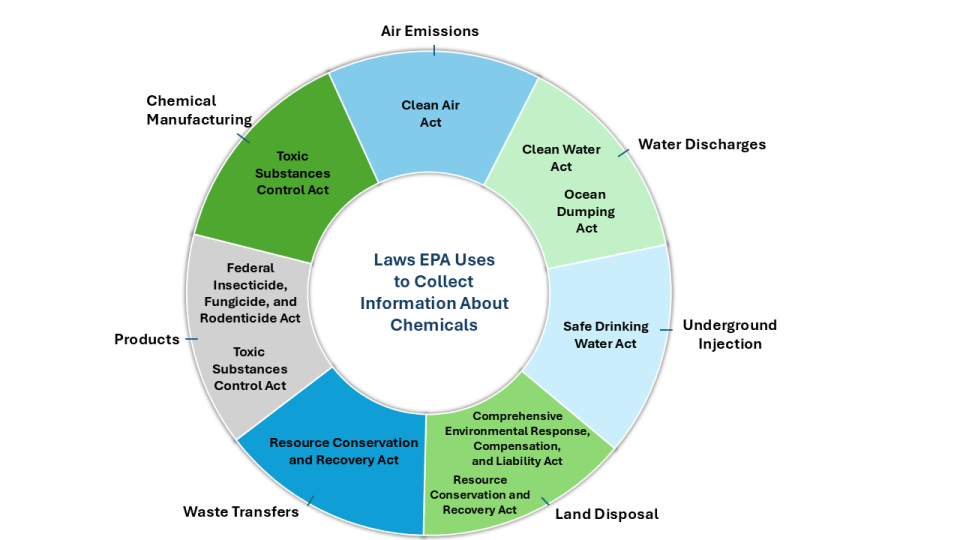What is the Toxics Release Inventory?
- What is the Toxics Release Inventory?
- What are TRI toxic chemicals?
- What industries are included in TRI?
- Why was the TRI Program created?
- Is the TRI a mandatory program?
- How is the TRI different than other regulatory programs?
- How does the TRI relate to other EPA programs?
What is the Toxics Release Inventory?
TRI tracks the waste management of certain toxic chemicals that may pose a threat to human health and the environment. U.S. facilities in certain industry sectors must report annually how much of each chemical they release into the environment and/or manage through recycling, energy recovery and treatment, as well as any practices implemented to prevent or reduce the generation of chemical waste.
The TRI Program fact sheet is available in English and Spanish.

The information submitted by facilities is compiled in the Toxics Release Inventory. TRI helps support informed decision-making by companies, government agencies, non-governmental organizations and the public.
Watch a short video about the TRI Program and your right to know.
What are TRI toxic chemicals?
In general, chemicals covered by the TRI Program are those that cause:
- Cancer or other chronic human health effects
- Significant adverse acute human health effects
- Significant adverse environmental effects
There are currently 799 individually listed chemicals and 33 chemical categories covered by the TRI Program. Facilities that manufacture, process or otherwise use these chemicals in amounts above established levels must submit annual reporting forms for each chemical. Note that the TRI chemical list doesn't include all toxic chemicals used in the U.S.
What industries are included in the TRI?
Facilities that report to TRI are typically larger facilities involved in manufacturing, metal mining, electric power generation, chemical manufacturing and hazardous waste treatment. Not all industry sectors are covered by the TRI Program, and not all facilities in covered sectors are required to report to TRI.

Congress originally determined the industry sectors covered by the the TRI Program, requiring reporting by facilities in the manufacturing sectors (as defined by Standard Industry Classification (SIC) codes 20 through 39). Congress also gave the EPA Administrator the authority to add sectors to or delete sectors from the scope of the TRI. Through this authority, EPA added seven industry sectors in 1997 and natural gas processing facilities in 2021. See the TRI Laws and Regulatory Activities webpage for details and to read about other changes to the TRI Program.
Why was the TRI Program created?
The TRI Program was created as part of a response to several events that raised public concern about local preparedness for chemical emergencies and the availability of information on hazardous substances.
On December 4, 1984, a cloud of extremely toxic methyl isocyanate gas escaped from a Union Carbide Chemical plant in Bhopal, India. Thousands of people died that night in what is widely considered to be the worst industrial disaster in history. Thousands more died later as a result of their exposure, and survivors continue to suffer with permanent disabilities. In 1985, a serious chemical release occurred at a similar plant in West Virginia.
In 1986, Congress passed the Emergency Planning and Community Right-to-Know Act (EPCRA) to support and promote emergency planning and to provide the public with information about releases of toxic chemicals in their community. Section 313 of EPCRA established the Toxics Release Inventory and required facilities to report environmental releases, waste transfers, quantities of chemicals on site, the type and location of storage of those chemicals, and their use to EPA (via the TRI Program) and to state and local officials.
Is the TRI a mandatory program?
The TRI is a mandatory program. The TRI Compliance and Enforcement webpage has more information.
How is the TRI different than other regulatory programs?
In 1986, the TRI was part of a new approach to environmental protection. By making information about industrial management of toxic chemicals available to the public, TRI creates a strong incentive for companies to improve environmental performance. Information disclosure programs such as TRI are different than most federal environmental programs that are designed to achieve better environmental performance by setting standards and specifying how facilities must operate.
The TRI Program is also different because the data it collects are:
- annual, collected each July and made publicly available online
- multimedia, reflecting chemical emissions to air, water and land
- broad, encompassing source reduction and other pollution prevention practices
How does the TRI relate to other EPA programs?
Numerous EPA programs use TRI data and information to:
- Provide a more complete picture of environmental performance at facilities and corporations
- Identify facilities that are potentially out of compliance with regulations or operating permits
- Support technical analysis for regulation
- Improve data quality across EPA
- Develop program priorities and projects
Under various environmental laws (identified in the figure below), other EPA programs also collect information about chemicals. Users seeking information not available in the TRI can check the databases associated with these other programs. The Clean Air Act's National Emissions Inventory (NEI), for example, can be used to find estimates of air releases for facilities that do not report to the TRI or for mobile sources such as cars, which TRI does not cover.

